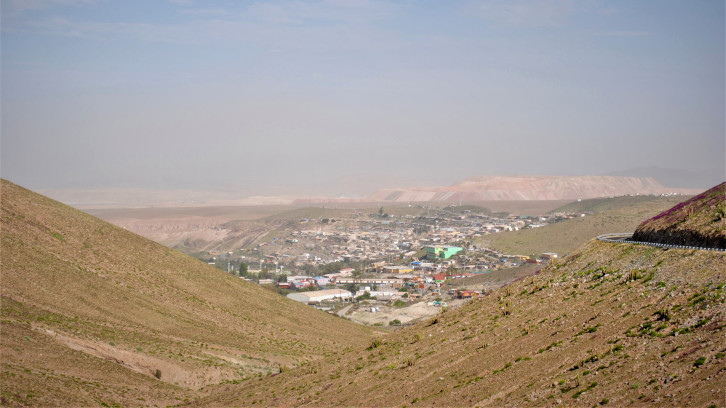Cultural dimensions of the water crisis in the Atacama Desert

The subsoil of the Atacama Desert in northern Chile stores large masses of water and rich deposits of mineral resources exploited by private companies, with highly lax regulations that represent a threat to the water reserves. UAB researchers lived with indigenous communities in the region to understand how they deal with this crisis.
The Atacama Desert, located mainly in northern Chile, is often referred to as the driest area in the world. It has been inhabited for thousands of years by various indigenous groups who have developed emblematic management of the area. Underneath its vast dry lands flow underground water masses that have accumulated more than 12,000 years ago since the ice age. At the same time, this region is the centre of one of the most important reserves of mineral resources, including copper, molybdenum, lithium, and other minerals.
In the early 1970s, Chile began to be prepared as a laboratory for neoliberal policies under the Pinochet dictatorship, which led to a constitution still in force today, privatising public goods, and state enterprises and exacerbating the notion of the private in society. Chile became a leader in this model with few regulations for environmental protection and a water policy that allowed for its capitalisation. As a result, the economic model facilitated some of the world's most significant copper mega-mining projects to start up in the Atacama Desert around the 1980s, making Chile a significant exporter.
The irruption of mining in the region began to produce conflicts among local communities and put stress on water resources. To give an estimate, the water allocation for mining companies is up to four times greater than that used for domestic consumption. One of these mining projects has extraction permits for more than 446,000 litres per hour. For this reason, the principal aquifer in the area has increased its use by more than 1800%. The problem with the water in the desert is that the recharge rate is at low or zero levels, so the reserves are in danger. A central equation by which there is consensus in defining a water crisis in the Atacama Desert; however, we discovered that this diagnosis is meant differently by the human groups that inhabit it. To gain an in-depth understanding of this phenomenon, we conducted ethnographic research in Mamiña, an indigenous Quechua community located a few kilometres from a mining project (see Figure). In an effort to understand how the community interacted with the problems of the crisis through their practices and discourses, we lived with them for more than six months.
Map of the study area. Source: Own elaboration.
Our results were conclusive on two levels of the problem. From a macro approach, we found that the crisis has broader management problems. Firstly, the private water management model is still in place, and environmental and indigenous protection laws are tangential, so communities were never consulted at the outset of the projects. Secondly, the government institution in charge of water management has problems in almost all monitoring stations in the area as there is no established protocol for sampling, and most of them do not meet the standards for the correct measurement of water. At the micro-social level, among other findings, we established that mining companies had generated clientelism among the communities by taking charge of needs that the state did not reach, for example, public works such as roads or squares. Over time, some regulations have emerged that oblige companies to conduct environmental impact studies. However, they have the possibility of trading environmental damage for monetary compensation, which has led to divisions among communities over the money given. On the other hand, communities have a different relationship with water issues. Despite being in the heart of the Atacama Desert, Mamiña has always maintained access to its waters and is one of the few communities that registered its usufruct rights without negotiating them with the companies, which has produced a bubble of security around the crisis affecting the area.
The findings allow us to expand on some aspects of the crisis. Firstly, the global water crisis is not only related to a biophysical issue of availability and exploitation. Although it is also the result of a governance problem, it has not been considered so far that the water crisis is also socio-culturally constructed from the particularities and meanings each human group can give it. Consequently, the analysis of the crisis must be articulated with the intersections of economics, politics, and history, and always from a situated approach, as there is no other way to approach the daily problems that affect human groups. Finally, Chile, a few days ago, rejected a new constitution that would have allowed it to face these problems. However, the permanence of the old constitution that exacerbates the importance of private property makes any legal instrument focused on the common social welfare insubstantial.
Raphael Cantillana
Anthropology and Fundamental Oriented Research Group (GRAFO)
Department of Social and Cultural Anthropology
Universitat Autònoma de Barcelona
Raphael.cantillana@uab.cat
Irene Iniesta-Arandia
FRACTAL Collective
The Institute of Environmental Science and Technology (ICTA-UAB)
Universitat Autònoma de Barcelona
Irene.iniesta@uab.cat
References
Cantillana, R. and Iniesta-Arandia, I. (2022) Beyond scarcity and its management: Sociocultural dimensions of the water crisis in the Atacama Desert, Water Policy, 24(7), pp. 1124–1145. DOI: 10.2166/wp.2022.297.


